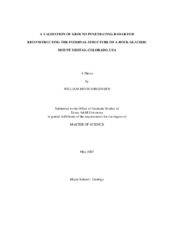| dc.description.abstract | Rock glaciers are dynamic landforms and, as such, exhibit interesting and welldeveloped
structural features, which translate to surface morphology in the form of ridges
and furrows. These distinguishing features have led researchers to study the physics
behind the movement and internal deformation of rock glaciers. For years researchers
had no access to the internal makeup of rock glaciers. Thus, proposed models and
discussion have been based on theoretical concepts of electromagnetic (EM) wave
propogation. With the application of ground penetrating radar (GPR) to provide a view
of the interior structure of a rock glacier, researchers had “real” data to verify their
models. However, no comparison has been made between a GPR profile and an actual
cross-section of a rock glacier. The purpose of this thesis is to validate the fidelity of
GPR in showing the actual structure of a rock glacier.
A trench that was excavated through the toe of a rock glacier on Mount Mestas in
south central Colorado provided a view of the actual structure of the landform. The
structure in the trench was compared with GPR and EM data. The GPR study was
conducted using a PulsEKKOTM 100A subsurface imaging radar with 25, 50, and 100 MHz antennas, to detect dielectric contrasts within the rock glacier. A frequency domain
EM34 by Geonics LtdTM was also used to supplement the GPR data by measuring the
rock glacier’s conductivity at various depths.
This thesis proved, by utilizing statistics, that GPR is a useful tool in visualizing
the interior structure of rock glaciers. The 100 MHz antennas clearly show small scale
reflection horizons caused by changes in clast orientation and subsurface material
composition. These events coincide with structures seen in the trench. Individual clasts
greater than 0.375 m were also recognized as point sources in the GPR profiles. Large
continuous bedding layers were observed with the 25 and 50 MHz antennas, which
reflect the structure seen in the trench. A large scale thrust fault was also located with the
GPR. However, this was not visible in the panoramic photograph because the fault
occurs below the base of the trench. | en |


